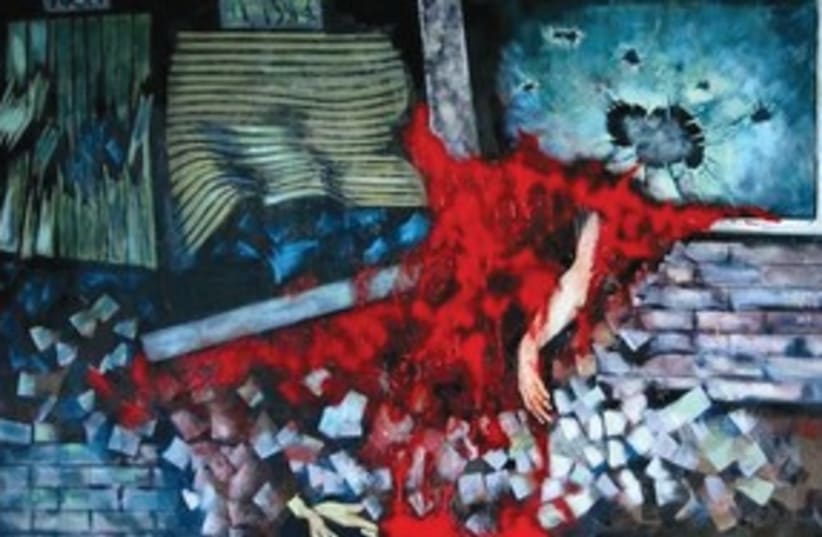The Farhud was a pogrom that took place in Baghdad and Basra on June 1 and 2 of 1941 that culminated in the murder of 180 Jews. During the purge, hundreds were injured and the homes and synagogues within the Jewish communities were looted and burnt to the ground.
The ceremony was organized by David Dangoor, who is a businessman and philanthropist who grew up in the Jewish community of Baghdad and now lives in the UK.
Considering the recent escalation between Israel and terror groups in the Gaza Strip, Dangoor felt it was especially important to highlight this pogrom to present what happens when antisemitism runs rampant.
“The Farhud was a tragic event that sounded the death knell for the oldest Jewish Diaspora community, but sadly is not well known around the world,” said Dangoor. “It is vital that the Jewish world and beyond commemorate the Farhud to understand better how to deal with hate, incitement and violence, and prevent such events from happening in the present and future.”
“Even up to the very end, many Jews and Arabs in Iraq refused to be enemies and lived and worked side by side," he added. "Animosity was largely imported from outside and incitement used as a tool for political goals. Unfortunately, we see many similar worrying signs in the violence in Israel, the US and Europe in recent days."
The commemoration had people across the world lighting virtual candles in honor of the victims of the pogrom. Facebook users also have the opportunity to apply a filter to their profile picture.
Each Shavuot, thousands of Jews from Baghdad remember the traumatic day when 2,400 years of Jewish life in Babylon came to an end.
Exactly 70 years ago, on the eve of Shavuot, some 700 Jews in the city were murdered in a Nazi-led pogrom known as the Farhud (“violent dispossession” in Arabic). Inspired by Kristallnacht, it marked the end of one of the oldest Jewish communities in the Diaspora and showed how far Hitler’s hatred of the Jews spread globally during World War II.
The Jews of Iraq had been living peacefully in Baghdad since the Babylonian era. By 1941, they numbered around 150,000, making up over a third of the population.
The monarchy in Iraq, installed by the UK, had been overthrown by the lawyer Rashid Ali al-Gaylani in April 1941, in a violent coup one month before the Farhud.
Rashid Ali had strong links to the Nazi Party and the grand mufti, a close ally of Hitler. Rashid Ali indoctrinated the country with Nazi propaganda; children in Iraqi schools were taught to praise Hitler and that Jews were a treacherous enemy, and Radio Berlin had regular broadcasts in Arabic.
Supported by the Nazis, he aimed to rid Iraq of Britain and to gain access to the huge oil reserves in Kirkuk.
An order was issued to Iraq’s air force to destroy the British RAF base in Habbaniyeh, west of Baghdad.
Although the RAF was only equipped with planes left over from World War I, the bombing campaign failed drastically, with Iraq’s inept air force shooting down several of its own planes.
On May 30, Rashid Ali was forced to flee. With British ground troops advancing on Baghdad and with no leader, the Jewish community was left in a perilous position.
Two days later, on June 1, the observant Jewish community was preparing for Shavuot, oblivious to a huge mob of rampaging Muslims shouting, “Cutal al yehud!” (slaughter the Jews).
With no organized resistance, many of the Jews who survived unscathed bribed Iraqi policemen to stand guard.
But the violence worsened during the night, and the mob soon numbered in the tens of thousands, targeting every Jewish home in the city. The mufti had made this task simple by advising the chief rabbi to ask the still-trusting Jewish community to paint a red hamsa (palm-shaped amulet used as a sign of protection) on the outside of their homes.
While the violence continued unabated, British troops were waiting on the outskirts of the city, forbidden to enter.
By the second day of fighting, the mob’s violence had spread to such a degree that Muslim shops were also being looted, and a curfew was eventually called at 5 p.m. Remaining violators on the streets were shot, and a relative calm was soon restored.
WHEN THE State of Israel was created, life in Iraq became unbearable, with public hangings of prominent Jews that shocked the community to new depths. When the Iraqi government finally allowed Jews to leave in 1950 on condition that they forfeit their nationality and all their money and property, the entire community registered en masse, leaving only 2,000 Jews by 1952.
Sarah Ehrlich contributed to this report.
